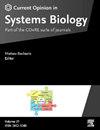利用代谢网络模型中基因组和蛋白质组学数据得出的资源约束
IF 2.2
Q2 BIOCHEMISTRY & MOLECULAR BIOLOGY
引用次数: 3
摘要
近年来,基因组学、蛋白质组学和代谢组学中可用的高含量数据越来越多,显著提高了基因组尺度代谢网络模型的预测能力和模型准确性。我们回顾了最近基于约束的建模方法,这些方法结合了基因组学和蛋白质组学数据来形成资源分配模型。不同的建模方法来建立资源分配模型和相关的酶约束基因组尺度代谢模型进行了讨论和评估,相对于模型特征的差异。此外,还概述了为不同方法构建、模拟和验证模型所需的数据,并列出了相关数据库的清单。本文章由计算机程序翻译,如有差异,请以英文原文为准。
Using resource constraints derived from genomic and proteomic data in metabolic network models
The increasing amount of available high-content data in genomics, proteomics, and metabolomics has significantly improved the predictive power and model accuracy of genome-scale metabolic network models in recent years. We review recent constraint-based modeling approaches that incorporate genomics and proteomics data to form resource allocation models. Different modeling approaches to build resource allocation models and the related enzyme-constrained genome-scale metabolic models are discussed and evaluated with respect to differences regarding model features. In addition, an overview of the data required to construct, simulate and validate models for the different approaches is given, together with a list of relevant databases.
求助全文
通过发布文献求助,成功后即可免费获取论文全文。
去求助
来源期刊

Current Opinion in Systems Biology
Mathematics-Applied Mathematics
CiteScore
7.10
自引率
2.70%
发文量
20
期刊介绍:
Current Opinion in Systems Biology is a new systematic review journal that aims to provide specialists with a unique and educational platform to keep up-to-date with the expanding volume of information published in the field of Systems Biology. It publishes polished, concise and timely systematic reviews and opinion articles. In addition to describing recent trends, the authors are encouraged to give their subjective opinion on the topics discussed. As this is such a broad discipline, we have determined themed sections each of which is reviewed once a year. The following areas will be covered by Current Opinion in Systems Biology: -Genomics and Epigenomics -Gene Regulation -Metabolic Networks -Cancer and Systemic Diseases -Mathematical Modelling -Big Data Acquisition and Analysis -Systems Pharmacology and Physiology -Synthetic Biology -Stem Cells, Development, and Differentiation -Systems Biology of Mold Organisms -Systems Immunology and Host-Pathogen Interaction -Systems Ecology and Evolution
 求助内容:
求助内容: 应助结果提醒方式:
应助结果提醒方式:


